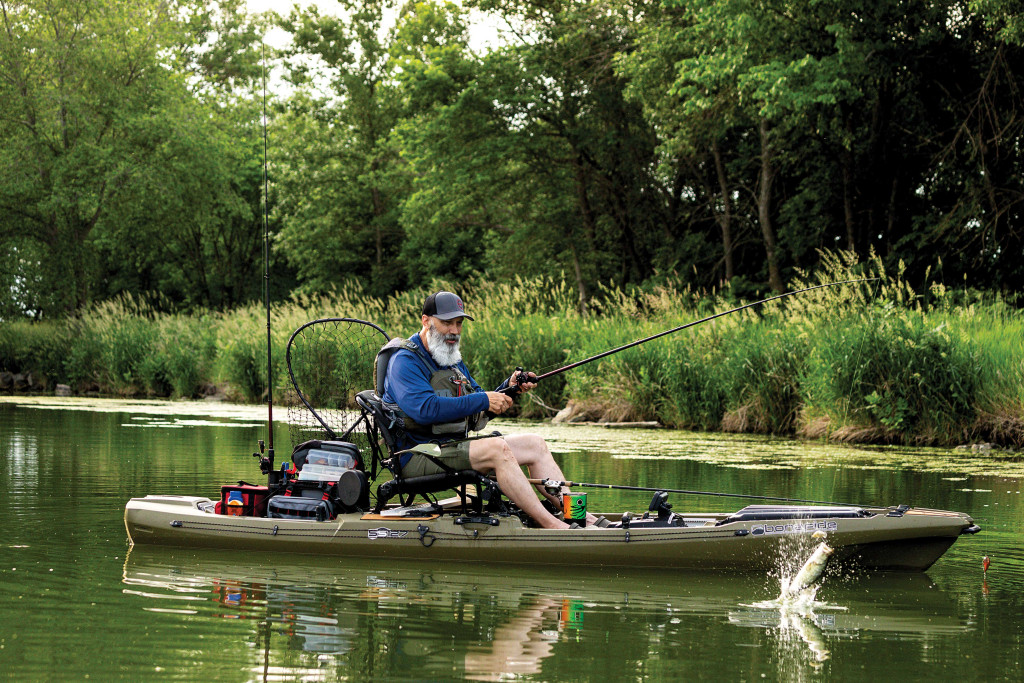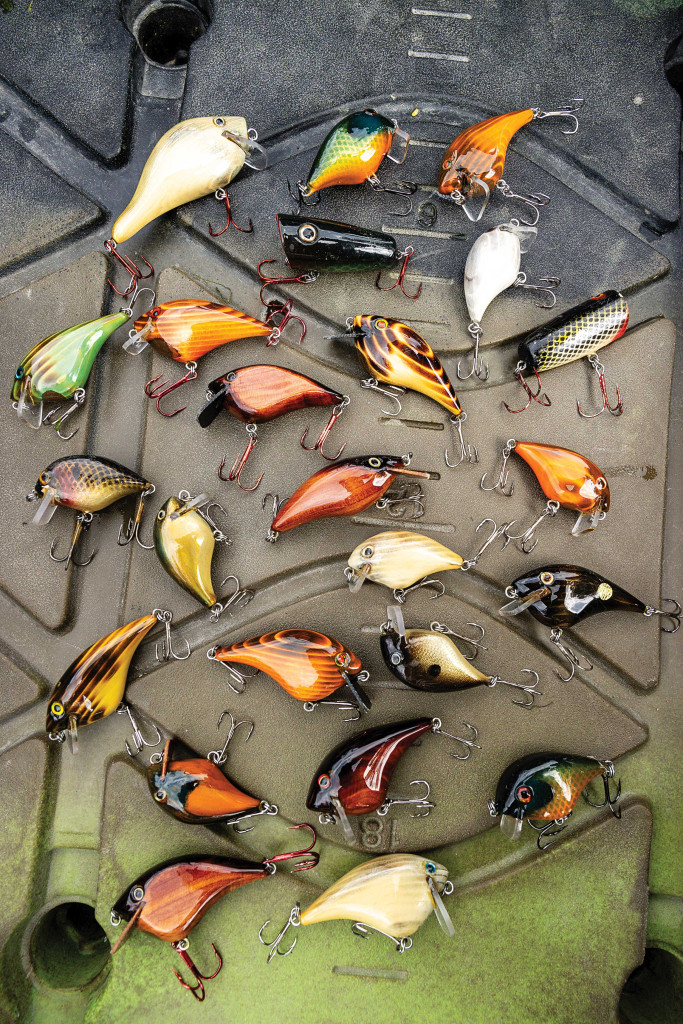
Story and photos by Jeff Kurrus
Wood-carved praying hands for his mother and obscene gesturing fingers for his father. This is the talent, and personality, of Weeping Water creator Vince Gewinner. Yet despite the multitude of carvings he’s made — from recurve bows and backwoods utensil sets to keychain ceramics and home décor — his current passion is homemade fishing lures.
But they’re not fishing lures to set on the shelf. They are not the equivalent of wooden waterfowl decoys. They are the opposite. Once they have been constructed, painted, and eventually dry, they are immediately wet again in search of everything from smallmouth and largemouth bass in Nebraska to muskies in Canada.
As long as they swim straight.
Then and Now
“You need to see the first lures I carved,” Vince grinned from the workshop behind his home, pulling two wooden crankbaits from a nearby shelf and even a Zara Spook stick-bait imitation hanging on the wall. “I tried the spook first. It doesn’t work worth a crap.”
Mal-shaped with childlike paint jobs, they are a far cry from what he is creating today, but still provide motivation for how far he has come in such a short time. He began carving fishing lures by hand less than two years ago.
“I first made lures I had fished with during my life, imitating ones I used as a kid,” Vince said. “Then, the more I learned, the more I began to create my own.” A process that took him a couple days in the beginning can now be completed in a couple hours. The speed and precision of this work being shown with a lure brought to him just the day before that he carved five different times to reveal his step-by-step process.
Everything about the lure he made in less than a day — from its shape to its eventual painting — was night and day from his first wooden creations.
Yet these lures still aren’t perfect, and for him that might be the best part. Today’s seeming perfection is tomorrow’s “what if we made this change,” knowing full well that there might be a misstep or two along the way.

Trial and Error
Vince is in constant trial-and-error mode, except for one aspect. He does know what will make a lure pretty. “It starts with looking for grain in the wood that will make a cool design or uniformity.” He demonstrates this by laying a piece of wood on his workbench. “See that knothole?” he asks. “That will look very cool.”
From there, he uses a bandsaw to cut out and sand the pattern until it’s in the general shape he desires. Then he begins his measurements — yet not from any sort of fancy, high-dollar tool.
“I stole a protractor from my kids when they were little,” he said, “and I’m constantly using it.” This is evident in how this elementary school math device constantly twists in his hands while he marks his newest lure with a pen.
He makes a series of measurements based around the centerline of the lure, noting the lip slot and where the weight will be added. After drilling a hole for the weight, which makes the lure easier to cast and helps it to sink when reeled, he takes a No. 7-sized split shot and hammers it flat, fitting it in a hole just beneath the lure’s lip.
“You have to experiment with this part a bit,” he said.
This remains the overarching suggestion of Vince’s process. While he would be the first to tell you he has formulas, and that his process has become more refined, he continues to watch videos and use around-the-house items, like his wife’s food scale, in an effort to make even nicer, more balanced, lures.
From here he uses a belt sander and file to remove any sharp points the lure might still have. Next comes sandpaper and then a piece of leather with rubbing compound.
“That makes the surface of the lure like glass,” he said. “Do you need to do that? Probably not. But I want it to look good.”
Painting comes next, and this is when the project really starts to take shape despite Vince’s most impressive miscue in his process. “I’m not very good with my paint,” he said with a knowing grin. “Because I don’t write down my paint mixtures. I should probably get a little better there.”
This statement becomes increasingly comical as Vince’s lures are seen, each matching the intended species precisely. If it’s a fish imitation, it looks exactly like that fish. However, sometimes he decides the grain of wood will be nicer than anything he could paint. With these, he simply dips the lure in spar urethane and allows the wood’s natural color to remain. These are some of his prettiest.
Once the lure dries, Vince adds wire ties, hooks and eyes.
Then it’s ready to test.
Testing Facilities
Where else would a talented wood carver test the practicality of his latest creation? A backyard swimming pool, of course. “I spend a lot of time at the pool,” he admitted.
Once Vince’s lures have been designed, and painted, he ties them on a rod and puts them to work in the pool, but not without a fair warning before he casts. “I can’t make any guarantees this will swim.” Like all crankbait anglers, he’s looking for a lure that wobbles seemingly uncontrollable as it swims but also in a straight line.
Minor adjustments can be made to help the lure, such as adjusting the lure’s tie eye, but sometimes they just don’t swim.
In these circumstances, Vince has a backup plan, as shown with a pair of pliers after several unsuccessful attempts at creating a beautiful, yet productive, fishing lure. He cut the line of the most recent lure he was testing and tossed it aside. “Put it on a keychain,” he said with a laugh. “I need to do some work on this design to get it to swim right.”
When the lures do pass his swim test, they are allowed a spot in the most coveted spot of all — the tackle box.
What’s Next
Wherever his mind takes him, and these ideas quite often come while he’s on the water testing his latest set of lures.
Maybe he’ll experiment with making deep divers, but he knows the complications they present with a longer lip. Plus, he doesn’t fish with them much and doesn’t make lures to gather dust on the mantel.
Perhaps he’ll turn his creativity to using more types of woods. While cedar is the easiest to work with, Vince has made lures using a variety of woods including pine, balsa and poplar. He’s also carved walnut cut for firewood and oak from a whiskey barrel.
Or he could go down his father’s route, who used to make his own maple stock muzzleloaders.
“I have a lot of ideas,” Vince said. And a lot of options for someone of his patience and talent. As long as whatever he makes — a lure, bow, or something in between — can pass the ultimate test.
Being ready for the field.
On a New Level
There’s a different level of excitement that arises when catching a big fish on public water. I always imagine these fish seeing hundreds of lures a year, so my pride swells a bit when my rod bends after hooking into a lunker.
I found out last summer that my pride swelled even more when fishing with a homemade crankbait. Easy to cast and retrieve, I quickly understood Vince’s joy when feeling a fish strike one of his lures. And it didn’t take long either, as I caught several nice largemouth bass on both Nebraska and Minnesota waters last summer.
One of Vince’s disappointments — a northern pike imitation — also saw the water last season. This lure doesn’t have the same wobble that his other, more refined, lures have. But the fish didn’t seem to care.
Because if it looks like a pike — and this lure most certainly does — it must taste like a pike.
